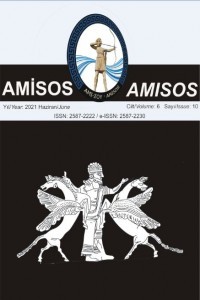SİBİRYA’DA ÜST PALEOLİTİK ÇAĞ’DA SİMGESEL DAVRANIŞLAR VE TAŞINABİLİR SANAT NESNELERİ
Sibirya’da Üst Paleolitik Çağ’ın başlangıcı, en azından, günümüzden yaklaşık 47.000 öncesine tarihlenir. Öncül Üst Paleolitik Çağ’ın nasıl ortaya çıktığı ve hangi insan -alt- türüyle ilişkilendirilmesi gerektiği konusunda tartışmalar sürerken, o evrenin başından itibaren görülen dilgi temelli taş endüstrilerinin gün ışığına çıkarıldığı kültür katmanlarından “simgesel davranışlar”ı işaret eden çok sayıda maddi kültür ögesi bulunmuştur. Anatomik açıdan modern insanların Avrasya’ya yayılımı ile ilişkilendirilen “modern davranışlar” (veya “davranışsal modernlik”) ve onun bir alt kümesi olan “simgesel davranışlar” kavramları altında tanımlanan pek çok unsurun Sibirya’da Öncül Üst Paleolitik Çağ’ın başından itibaren görülmesi, o yeni kültürün modern insan topluluklarına atfedilmesi yönünde önemli bir destek olarak görülebilir. Bu makalede, Sibirya’da Üst Paleolitik Çağ’ın başlangıcı hakkındaki hipotezleri, sorunları; o çağda görülen “simgesel davranışlar”a işaret eden bulguları ve öne çıkan örnekleri; ölü gömme ve inanca ilişkin bulgular, süs nesneleri ve takılar, taşınabilir sanat nesneleri, iki boyutlu betimlemeler, kaya ve mağara resimleri başlıkları altında incelemeye çalışacağım.
Anahtar Kelimeler:
Sibirya, Üst Paleolitik Çağ, Simgesel Davranışlar, Paleolitik Sanat, Taşınabilir Sanat Nesneleri
SYMBOLIC BEHAVIOR AND PORTABLE ART OBJECTS IN THE UPPER PALEOLITHIC IN SIBERIA
The beginning of the Upper Paleolithic in Siberia, at least, dates back to about 47,000 years ago. While there are debates about how the Initial Upper Paleolithic emerged and which human species it should be associated with, many material culture elements that point to "symbolic behavior" were found from the cultural layers where blade-based stone industries were exposed from the beginning of that phase. From the beginning of the Initial Upper Paleolithic in Siberia, the occurrence of many elements defined under the concepts of "modern behavior" (or "behavioral modernity"), and a subset of it, "symbolic behavior", which are associated with the spread of anatomically modern humans to Eurasia, can be seen as an important support for the attribution of the new culture to modern human populations. In this article, I tried to examine the hypotheses and problems about the beginning of the Upper Paleolithic in Siberia; findings and prominent examples indicating the "symbolic behavior" seen during the Upper Paleolithic as categorized them under the headings of the evidences that related burial and belief system and the findings including ornaments and jewelry, portable art objects, two-dimensional depictions on osseous plates, rock and cave arts.
Keywords:
Siberia, Upper Paleolithic, Symbolic Behavior, Paleolithic Art, Portable Art Objects,
___
- Abramova, Zoya A.; Page, Catherine vd. (1967). “Palaeolithic Art in the U.S.S.R.”, Arctic Anthropology, Vol. 4, No. 2. (1-179)
- Akimova, Elena V.; Higham, Tristan vd. (2010). “A new direct radiocarbon AMS date for an Upper Palaeolithic human bone from Siberia”, Archaeometry, 52(6). (1122-1130)
- Altın, Vural (2007). İklim Dinamikleri, TÜBİTAK Bilim ve Teknik Dergisi Eki, Şubat Sayısı.
- Bar-Yosef, Ofer ve Wang, Youping (2012). “Paleolithic archaeology in China”, Annual Review of Anthropology, 41. (319-335)
- Bar-Yosef, Ofer; Eren, Metin I. vd. (2012). “Were bamboo tools made in prehistoric Southeast Asia? An experimental view from South China”, Quaternary International, 269. (9-21)
- Bar-Yosef, Ofer ve Belfer-Cohen, Anna (2013). “Following Pleistocene road signs of human dispersals across Eurasia”, Quaternary International, 285. (30-43).
- Bednarik, Robert G. (1994). “The pleistocene art of Asia”, Journal of World Prehistory, 8(4). (351-375)
- Bednarik, Robert. G. (1997). “The global evidence of early human symboling behaviour”, Human Evolution, 12(3). (147-168)
- Bednarik, Robert. G. (2010). “An overview of Asian palaeoart of the Pleistocene”, In Proceedings of the IFRAO Congress, September 2010 – Symposium: Pleistocene art of Asia (Pre-Acts). (1-12)
- Belousova, Natalia E.; Rybin, Evgeny P. vd. (2018). “Kara- Bom: new investigations of a Palaeolithic site in the Gorny Altai, Russia”, Antiquity, 92(361). (1-7)
- Berkant, Evrensel B. (2020). Genetik ve Arkeolojik Araştırmalar Işığında Üst Paleolitik Çağ'da Arkaik Altay Halklarının Doğu Sibirya'dan Göçleri, Dokuz Eylül Üniversitesi, İzmir. (Yayımlanmamış Doktora Tezi).
- Buvit, Ian ve Terry, Karisa (2011). “Last Glacial Maximum human populations in the southwest Transbaikal, southern Siberia”, From the Yenisei to the Yukon: interpreting lithic assemblage variability in Late Pleistocene/Early Holocene Beringia. Editors T. Goebel, I. Buvit. Texas: Texas University Press. (ss. 45-57)
- Buvit, Ian; Terry, Karisa vd. (2015). “The emergence of modern behavior in the Trans-Baikal, Russia”, Emergence and Diversity of Modern Human Behavior in Paleolithic, Editors Y. Kaifu, M. Izuho, T. Goebel, A. Ono., Texas, Texas University Press. (490-505)
- Buvit, Ian; Izuho, Masami vd. (2016). “Radiocarbon dates, microblades and late Pleistocene human migrations in the Transbaikal, Russia and the Paleo-Sakhalin-Hokkaido-Kuril Peninsula”, Quaternary International, 425. (100-119)
- Clark, Peter U.; Dyke, Arthur S. vd. (2009). “The last glacial maximum”, Science, 325(5941). (710-714)
- Dikov, Nikolai N. (2004). Early cultures of northeastern Asia, US Department of the Interior, National Park Service, Shared Beringian Heritage Program, Alaska.
- Derevianko, Anatoly P. (2011). The Upper Paleolithic in Africa and Eurasia and the Origin of Anatomically Modern Humans, International Symposium Features of the Upper Paleolithic Transition in Eurasia: Cultural Dynamics and the Evolution of the Genus Homo: Denisova Cave, the Altai, 4-10 July, 2011, Editor M. V. Shunkov, Institute of Archaeology and Ethnography SB RAS Press, Novosibirsk, Russian Federation.
- ISSN: 2587-2222
- Yayın Aralığı: Yılda 2 Sayı
- Başlangıç: 2016
- Yayıncı: Davut YİĞİTPAŞA
Sayıdaki Diğer Makaleler
LYKAONİA’DA MİTHRAS KÜLTÜNÜN İZLERİNE DAİR BAZI DEĞERLENDİRMELER
GÜNÜMÜZE ULAŞAMAYAN BİR KÜLTÜR MİRASI: KOYUNYERİ KÖYÜ CAMİİ
Murat KARADEMİR, Melike DEMİRTAŞ
PİSİDİA BÖLGESİNDEKİ KARADİĞİN TEPESİNDEN OK VE MIZRAK UÇLARI
Abdulhadi DURUKAN, Ahmet Cuneydi HAS
Mesut YILMAZ, Serap SEVGİ, Bekir ESKİCİ, Yaşar Selçuk ŞENER, Mevlüt ELİÜŞÜK
PLEİSTOSEN HOMİNİNLERİNDEN MODERN İNSANA: ÖMÜR UZUNLUĞUNDA MEYDANA GELEN DEĞİŞİMLER
SİBİRYA’DA ÜST PALEOLİTİK ÇAĞ’DA SİMGESEL DAVRANIŞLAR VE TAŞINABİLİR SANAT NESNELERİ
KAUNOS´TAN KABARTMALI PITHOS PARÇALARI
ALSANCAK HOCAZADE AHMED RAGIB ÜZÜMCÜ CAMİİ KUBBE YAZISI
ÇAKALCA – KARADOĞAN HÖYÜĞÜ KURTARMA KAZISI: AMİSOS’TA MİLETOS KOLONİZASYONUNA DAİR BULUNTULAR
